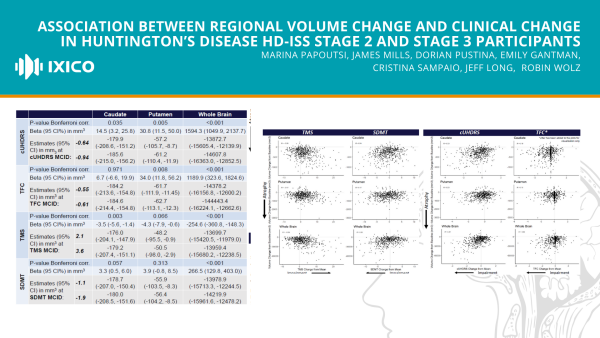Association between regional volume change and clinical change in Huntington’s disease HD-ISS Stage 2 and Stage 3 participants

Summary:
For HD-ISS Stage 2 and Stage 3 participants, whole-brain volume shows significant association with clinical change for all four clinical variables examined here. For caudate and putamen volume, the association depended on the clinical variable. Our results provide further evidence on the use of volume change as a surrogate endpoint.
Caudate, putamen, and whole-brain volume are important biomarkers in Huntington’s disease (HD) and could play an important role as reasonably likely surrogate endpoints in clinical trials.
We used a subset of data from TRACK-HD/TrackOn-HD and PREDICT-HD studies, which have been processed as part of the HD Imaging Harmonization (HD-IH) consortium to perform volumetric analyses using deep learning and the generalized Boundary Shift Integral.
We provide preliminary results on the relationships between the three regions of interest and the changes which could play an important role as a reasonably likely surrogate endpoint in clinical trials.
Method
We analyzed data from 315 HD-ISS Stage 2 and 169 Stage 3 participants and performed a “change-with-change” analysis in which regional volume change was predicted by clinical variable change. Linear mixed models (LMMs) with random intercepts were used.
Results
The interaction between HD-ISS Stage and change in the clinical score was not significant after multiple comparisons correction for any of the clinical scores and ROIs. Therefore, we only present the main effect of clinical score change.
Download